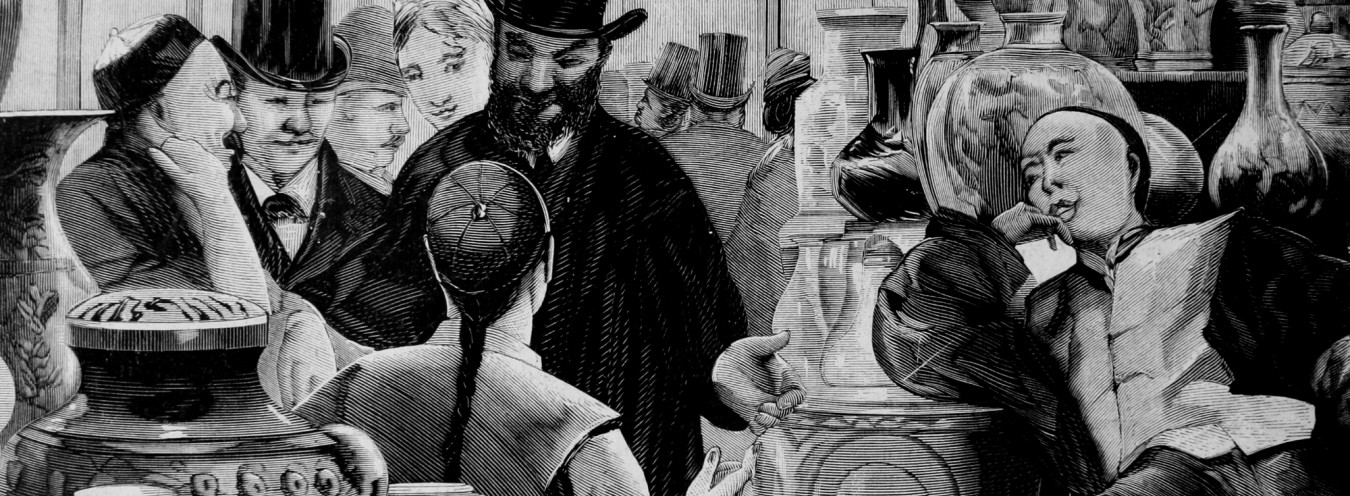
Paris and the World’s Fair
Wokulski visits Paris to meet with the merchant Suzin, currently staying there on business, and to see the World’s Fair (Exposition Universelle) opened in May 1878. At first sight, the city impresses him as an extraordinary place. The train already station seems remarkable, and what catches Wokulski’s attention are turmoil and noise, on the one hand, and the structure of the platform hall, which makes him think that The train had stopped under a roof on the other. The roof over the station’s communication area (Paris Gare du Nord hall, modelled on other massive European terminals, was an iron and glass construction) is the hallmark of a modern metropolis, whose infrastructure simultaneously meets two criteria: it increases the speed of its users’ mobility and it allows for the traffic to be controlled. Wokulski catches his first glimpses of Paris from the perspective of the carriage that he takes with Suzin from the station to the city centre, driving down a wide and straight boulevard, which is an almost ideal extension of the railway tracks that brought him to the city. Rue La Fayette is a part of the great renovation of Paris, designed and executed under Georges Haussmann between 1852 and 1869. The premises of the project were partly economic, partly political. The political rationale was adjust the city to military operations and pacifications, whose effectiveness (as past experiences evidenced) was diminished due to the dense downtown buildings and a network of narrow, crooked streets (dating back to the Middle Ages), which were ideally suited to the construction of barricades and hindered the use of the cavalry or heavy weaponry. The modernizing ambitions of Emperor Napoleon III, who envisioned a city designed as a whole, where specialised parts perform certain functions and are connected with streets that enable efficient intercity communication were on top of these military requirements of the renovation. Haussmann’s design revolutionised the function of streets and squares; whereas in medieval Paris these were primarily meeting places that held public services, now a new purpose – ornamental and ceremonial – was added. Modern Paris was supposed to facilitate mobility, and thus follow the already well-developed French (and European) railway network. The renovation was modelled on the contemporary railway construction. Accordingly, a city plan was the starting point of the endeavour. It was the first plan of Paris as a whole (before that, there were only maps of individual districts). The main assumption underlying the renovation was that the newly charted routes were supposed to accelerate and intensify city traffic, and thus the boulevards were supposed to run in straight lines, which made it necessary to sacrifice the existing housing (about 20,000 buildings were demolished). The boulevard routes cut across the centre of Paris, connecting it with the outskirts and with massive railway stations, which offered transport to the French provinces.
Wokulski experiences Paris also from the pavement perspective, which enables a more accurate depiction of the housing structure (five-storey buildings with uniform facades, streets lined with trees). Apart from visiting parts of the metropolis, he simultaneously studies the entire city with its plan. Both ways of becoming acquainted with Paris (walks or drives and the guide) enable Wokulski to get an idea of the great modern city: its structure resembles a living organism, whose individual elements are held together with a spine (running from the Bastille to the Arc de Triomphe), and they fulfil functions analogous to internal organs (Les Halles supply provisions, wide streets and parks provide good ventilation, the sewage system disposes of waste).
Paris offers so many unexpected attractions to the Polish visitor that his main goal – visiting the World’s Fair – is overshadowed by the immensity of other experiences. The Paris Fair continued the tradition of events, commenced in London in 1851, which were cyclically organised to present the achievements of individual countries in different fields, with a special focus on the progress in technology and industry. The 1878 Fair was also meant to convince the visitors that the French economy had successfully managed to recover from the effort exerted in the Franco-Prussian War. Almost half of the exposition space was devoted to the presentation of French achievements, and the rest was unequally divided among the remaining countries (as much as a third of the area was assigned to Great Britain and the colonies, whereas Germany was excluded from the Fair). The main exhibition halls, of which Gallery of Machines stood out as the most impressive, were erected on the left bank of the Seine. The telephone and the phonograph were among the most important of the many technological achievements and inventions exhibited. In June, at the Place de l’Opéra yet another novelty was presented: electric lighting (arc lamps). At the fair, Wokulski also has the opportunity to see the flying machines that fascinate him so much. During the exposition, the visitors could fly several hundred metres above the city in the gondola of a captive balloon. They could also see the du Temple Monoplane, one of the first aircrafts that were heavier than the air (capable of several-hundred-meter flights).
→ Baedeker; → Discoveries and Inventions;



